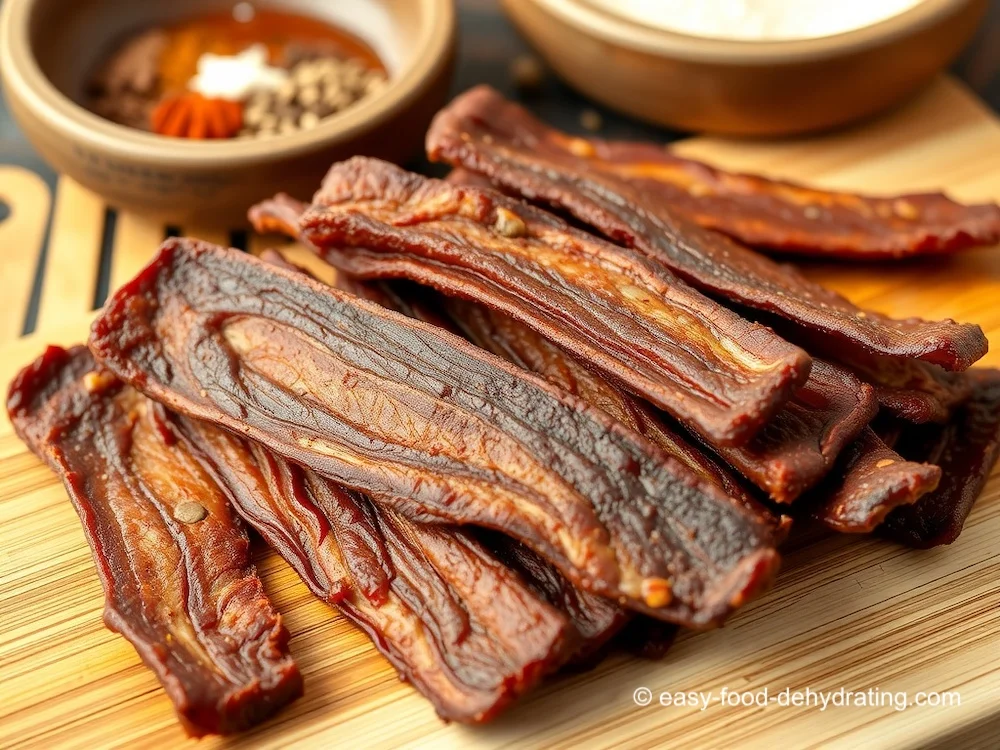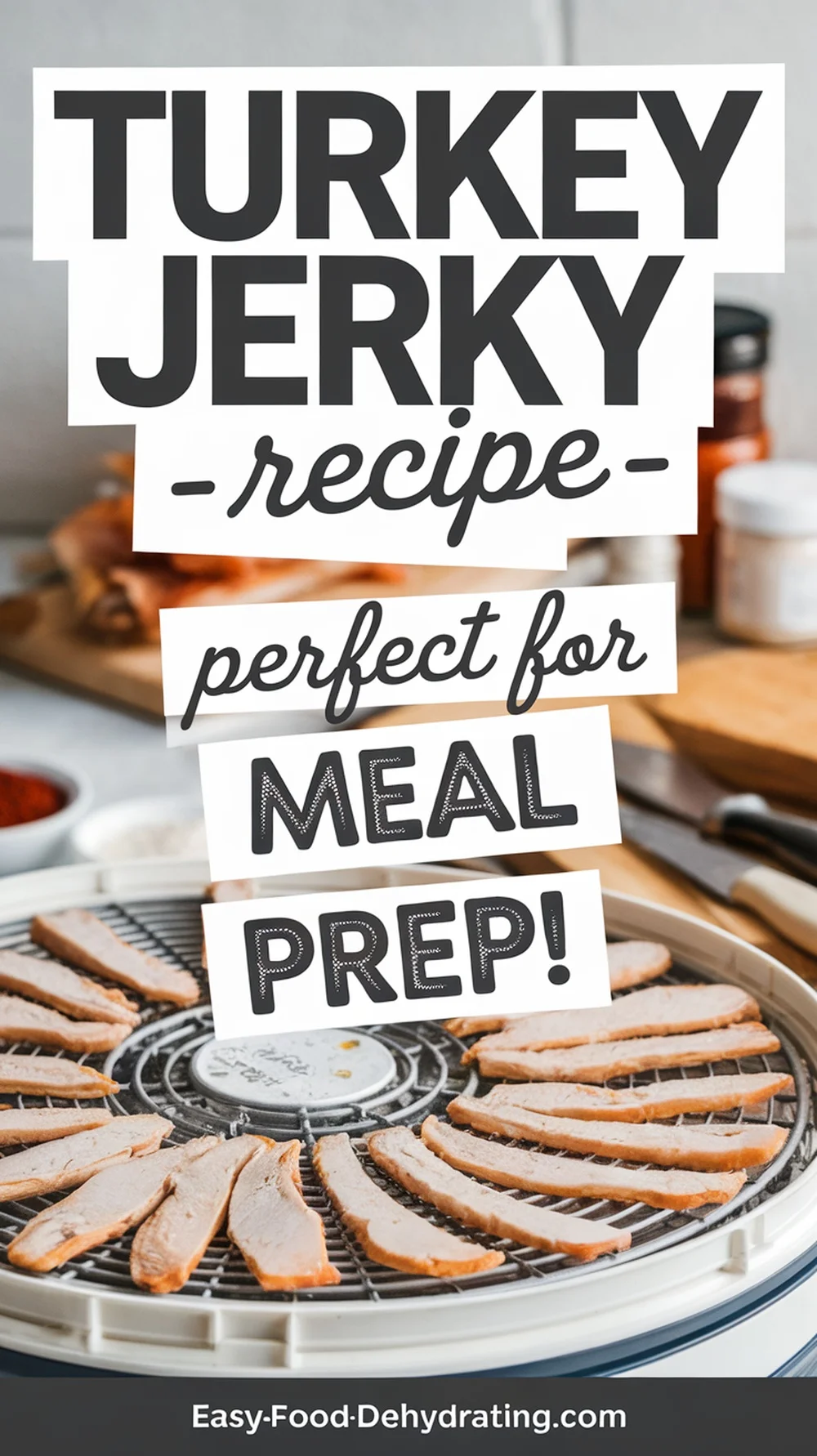What We Mean by “Dehydrate”
Here at Easy Food Dehydrating, “dehydrate” always means using an electric food dehydrator — the easy, reliable way to dry food at home.
- Home
- How to Dehydrate Turkey
How to Dehydrate Turkey (Safely & Easily)

Wondering how to dehydrate turkey safely and easily? Whether you're prepping for backpacking, long-term food storage, or just want a quick, protein-packed snack, you’re in the right place. I’ll show you how I do it — from store-bought sliced turkey to homemade jerky — no guesswork required.
✅ Quick Answer: How Do You Dehydrate Turkey?
To dehydrate turkey, use fully cooked meat sliced evenly. Arrange on dehydrator trays and dry at 160°F for 4–6 hours until crisp. For oven drying, use the lowest temp, prop the door open slightly, and check often. Never dehydrate raw turkey — it must be fully cooked first.
But guess what? I cheat. There, I said it. I buy pre-sliced cooked turkey in tubs. Or you can stand in line and buy it freshly sliced at the deli. Ask for your turkey to be sliced at medium thickness.
But shown below, I'm cutting up leftover Thanksgiving turkey!
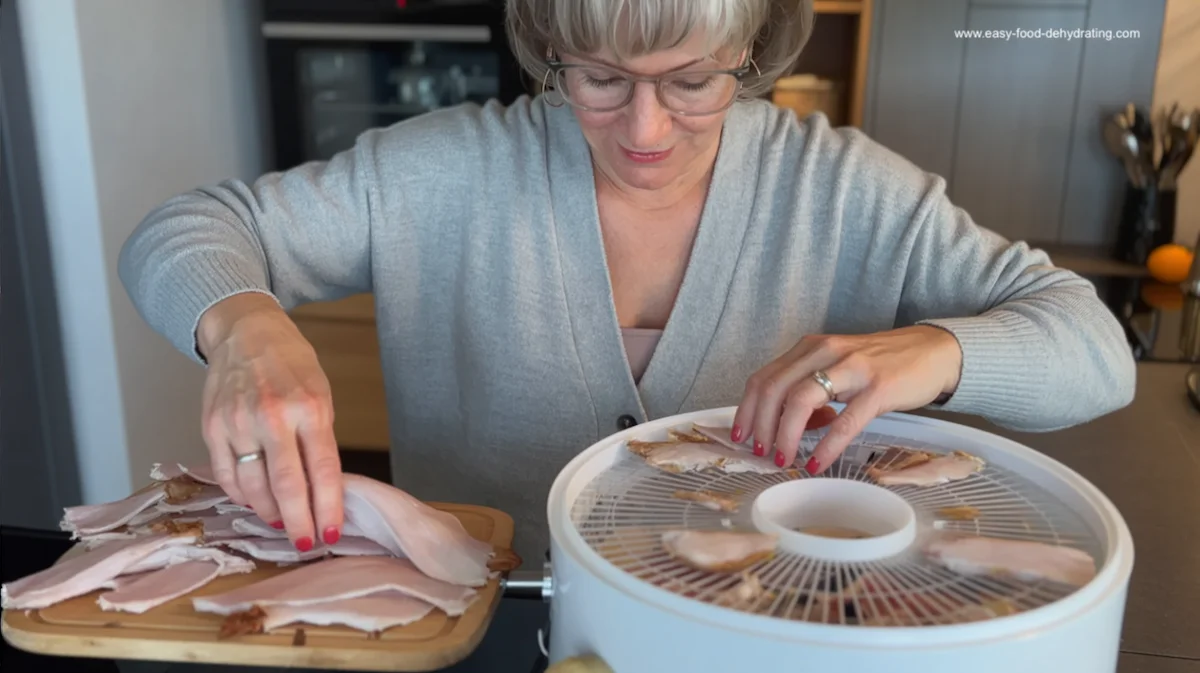
Dehydrating pre-cooked, deli-sliced turkey is a simple process that obviously requires minimal effort!
If you don't want to buy processed sliced turkey look for boneless skinless turkey meat instead. Turkey breast is ideal. The key is to cut fresh turkey strips into even strips so they dehydrate at the same rate.
If you wish to use ground turkey, use the plastic "clean-a-screen" liners (Amazon affiliate link) like you see in my image below with the two "finger cut-outs" on the edge. This screen helps stop small pieces of meat (or anything!) from falling through to the bottom of the dehydrator. They also aid in the "stickiness" department.
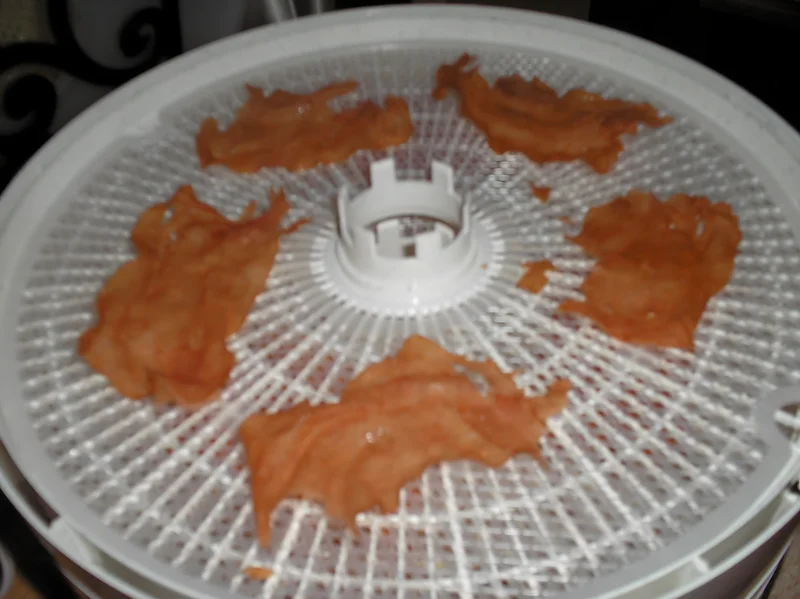
In the image above, I used a 9 oz. tub of sliced turkey from Target and placed five slices per tray for the Nesco Food Dehydrator. I also recommend Walmart and Publix brands sliced turkey.
What you see are the shrunken slices - if you're wondering why there aren't more slices on the tray.
How to Prep Turkey for Even, Safe Dehydrating
Why Consistent Slices Matter for Safe Drying
When dehydrating turkey (or any meat), cut pieces to uniform sizes for even drying. Uneven pieces may lead to some being over-dried while others remain too moist, which isn’t safe for storage.
If you accidentally put away processed meat that is still warm or damp in the center, you run the risk of salmonella poisoning. Be safe. Dry the turkey fully and allow to cool to room temperature before using for backpacking meals or long-term storage in your food pantry.
Making Turkey Jerky is different: The spices you use act as a preservative for the raw meat. See my turkey jerky recipe further down the page.
Using leftover meats like pork, chicken, or beef? No problem! Simply slice them evenly before dehydrating.
Best Dehydrating Temperature for Turkey (+ My Top Tips)
Step-by-Step Instructions for Dehydrating Sliced Turkey
- Arrange pre-cooked, pre-sliced turkey in a single layer on dehydrator trays.
- Do not overlap slices to ensure even drying.
- Set your dehydrator to 160°F and dry for approximately 2 hours.
- Rotate trays midway for uniform dehydration (even if the manual doesn't mention it!).
- The turkey is fully dehydrated when crispy and breakable.
💡 Tip: Outside the U.S.? Most dehydrating temps here are listed in Fahrenheit - use our quick converter to see the Celsius equivalent for your machine.
💡 Storage Tip: Store in vacuum-sealed bags with a 100cc oxygen absorber to maintain freshness, scroll down to see my images.
No Dehydrator? Here’s How to Use Your Oven Instead
No dehydrator? Use your oven!
- Preheat your oven to its lowest setting (usually 170°F or lower).
- Place turkey slices on a wire rack that's on top of a baking sheet for airflow.
- Prop the oven door open slightly with a wooden spoon - it lets moisture escape.
- Check turkey every few hours and remove once it reaches the desired texture.
⛔ Important: Always Use Cooked Turkey Only:
We are NOT dehydrating RAW turkey—only cooked turkey is safe for dehydration. Always follow your food dehydrator's manual for exact settings.
🔥 Why 160°F Is the Safe Zone for Meat 🔥
Don’t Take Chances When Dehydrating Meat
If you’re drying plain, cooked turkey (or any cooked meat), always set your dehydrator to 160°F - it’s the safe zone that kills bacteria like Salmonella and E. coli.
👉 If you’re making jerky from raw meat, it must be properly marinated using salt and/or curing ingredients that help inhibit bacterial growth. The spices and acids act as preservatives - but it still needs to be dehydrated at 160°F.
⚠️ Never try dehydrating raw, unseasoned turkey or ground meat without first cooking it - that’s a serious safety risk.
Don’t Take Chances When Dehydrating Meat
If you’re drying plain, cooked turkey (or any cooked meat), always set your dehydrator to 160°F - it’s the safe zone that kills bacteria like Salmonella and E. coli.
👉 If you’re making jerky from raw meat, it must be properly marinated using salt and/or curing ingredients that help inhibit bacterial growth. The spices and acids act as preservatives - but it still needs to be dehydrated at 160°F.
⚠️ Never try dehydrating raw, unseasoned turkey or ground meat without first cooking it - that’s a serious safety risk.
How to Make Easy, Flavor-Packed Turkey Jerky
See how easy it is to make this homemade turkey jerky recipe here!
Try These Other Jerky Recipes Too
Check out these Jerky Treats pages:
Fish Jerky, Beef Jerky, Chicken Jerky, Hot Honey Chicken Jerky, and Pork Jerky!
Rehydrating Dehydrated Turkey: How to Bring It Back to Life
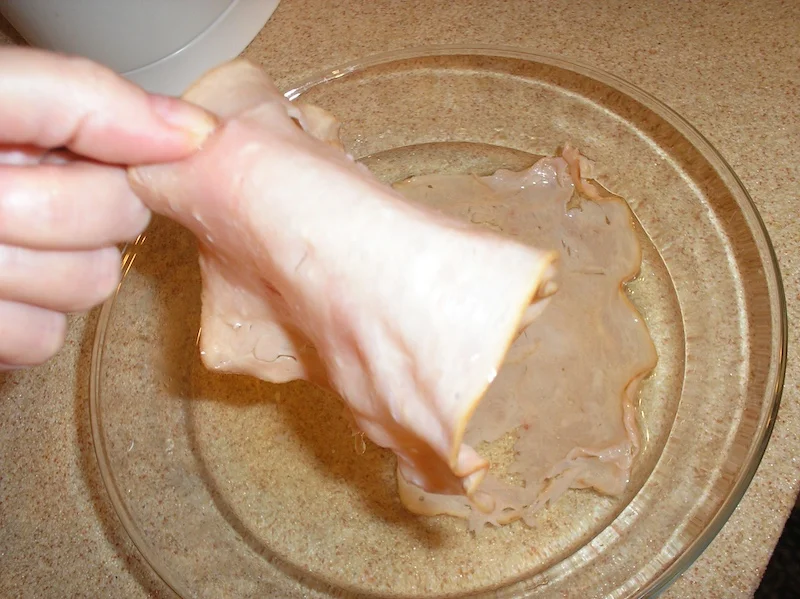
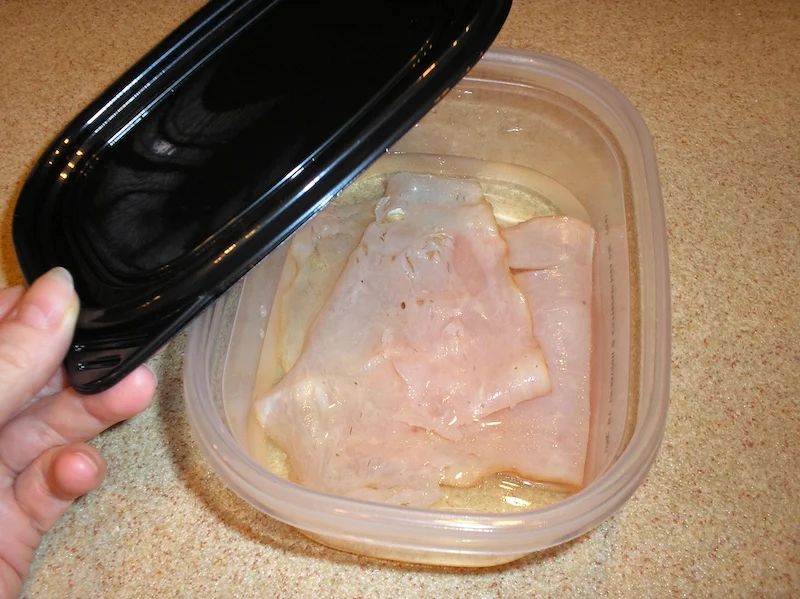
Rehydrated turkey is back to being moist and flavorful—not stiff or crispy!
What to Use for the Best Rehydration Results
✅ How to Rehydrate:
- Soak in clean, cold water using a few cups water in the refrigerator.
- Use chicken or turkey stock for added flavor (I love Better Than Bouillon stock!).
- NEVER rehydrate at room temperature—this can promote bacterial growth, especially in hot climates.
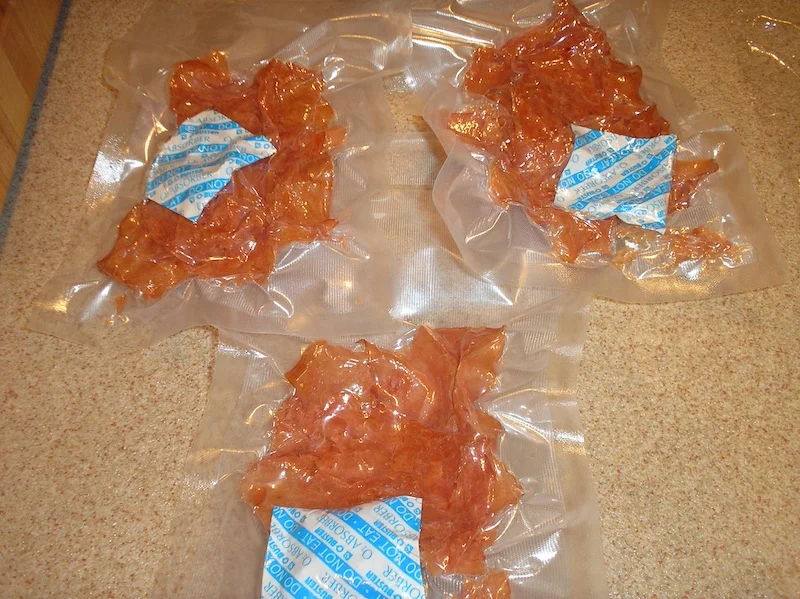 Pre-cooked sliced turkey individually vacuum-packed with an oxygen absorber
Pre-cooked sliced turkey individually vacuum-packed with an oxygen absorberIn the photo, you can clearly see three packages of pre-cooked turkey, all vacuum-sealed with their oxygen absorber packs and ready to store.
Dehydrating Leftover Turkey (Post-Thanksgiving Hack)
If you’ve ever stared at a fridge full of Thanksgiving turkey and wondered, “What am I going to do with all this?” - dehydrating it is the perfect solution. Instead of letting those leftovers dry out or spoil, you can preserve them for months and use them in delicious meals long after the holidays.
Here’s how to do it:
- Trim & Prep: Remove any skin, fat, or gristle (these don’t dehydrate well). Shred or cube the leftover turkey into bite-sized pieces.
- Since your turkey is fully cooked, you can move straight to slicing and dehydrating.
- Dry as Usual: Spread evenly on your dehydrator trays and dry at 160°F (71°C) until the pieces snap or crumble when cooled.
- Store Properly: Once completely dry, vacuum-seal the turkey in small portions. It will last up to 6 months at room temp or a year+ in the freezer.
How to Use It Later:
Simply rehydrate the turkey in hot water or broth until tender, then stir it into creamy rice for a comforting, post-holiday meal. You can also add it to soups, casseroles, or even backpacking meals for quick protein on the go.
One of my favorite ways to bring dehydrated turkey back to life is in Mom’s Turkey Risotto, shown below.
My Family’s Favorite: Mom’s Turkey Risotto Recipe
Once your turkey is dehydrated, you can rehydrate it and use it in a variety of dishes. One of my family’s favorites is Mum’s turkey risotto.
Turkey Risotto Recipe
One of my favorite childhood memories is my mom’s Turkey Risotto. She made it every Christmas in the UK. When I moved to the USA, I was thrilled to have another chance to enjoy it on Thanksgiving!
 with added broccoli!
with added broccoli!ingredients:
- 1 cup cooked turkey
- 1 can of diced tomatoes
- 1 small can of peas
- 1/2 white onion, chopped
- Handful of mushrooms, sliced
- 1 tsp Italian herbs
- 1 cup of chicken or turkey stock
- Salt & pepper, to taste
- 1 1/2 cups long grain rice (precooked)
Instructions:
- In a large pan, sauté onions and mushrooms in a little oil.
- Add tomatoes, peas, stock, and herbs.
- Simmer for 15 minutes, then stir in cooked turkey.
- Serve over rice or orzo.
🍽️ Tip: Orzo cooks twice as fast as rice!
💖 Dedicated to Mom (1936-2021)—I miss her dearly and hope you love this recipe as much as my family did.
If you wish to add a splash of white wine, try adding 1/4 cup to the recipe while simmering.
If Using Dehydrated Turkey: Simply rehydrate by soaking the dehydrated turkey in hot water or broth for 15–20 minutes before adding to the risotto.
How to Make Dehydrated Turkey Treats for Dogs
And since turkey isn’t just for us humans, here’s how I make safe, homemade turkey treats for dogs.
 Homemade dehydrated turkey treats
Homemade dehydrated turkey treatsHere's how to dehydrate turkey necks in particular for tasty dog treats. Turkey necks provide protein, minerals, and glucosamine that support your dog's health.
Here are some turkey neck tips:
- Ensure turkey necks are fresh, raw, and thoroughly cleaned.
- Cook the meat in water until cooked through. Allow to cool.
- Slice into evenly sized chunks for dehydrating.
- Arrange in a single layer on trays, avoid overlapping.
- Dehydrate at 160°F, flipping occasionally, for 8-15 hours until turkey chunks are completely dry.
Fully dried turkey necks will have shrunk considerably in size. To test, the jerky should not bend (a tad) and almost snap when attempting to tear it apart.
Allow the turkey neck treats to cool completely before giving them to your dog. Store any extras in an airtight Mason jar or food vacuum sealer bags for up to 2 months.
Always keep an eye on your dog while he's eating them to prevent choking.
For safety, dehydrate turkey parts into a shelf-stable jerky texture. Adding broth (for more flavor) or water restores some moisture for easier chewing if your dog struggles with the texture.
More Meat Dehydrating Guides You’ll Love!
Loved learning about dehydrating turkey? Check out our guides for:
Your Top Questions About Dehydrating Turkey—Answered!
How long does turkey take to dehydrate?
How long does turkey take to dehydrate?
The dehydration time for turkey depends on the thickness of the slices and the temperature setting of your dehydrator.
Generally, thinly sliced cooked turkey takes 6 to 10 hours at 160°F until fully dried. Always check that the turkey is dry but still slightly pliable, and almost brittle.
Do you need to cook turkey before dehydrating?
Do you need to cook turkey before dehydrating?
Yes, turkey must be fully cooked before dehydrating. Raw poultry can harbor bacteria like Salmonella, so it’s essential to cook it to an internal temperature of 165°F (74°C) before slicing and dehydrating.
Using lean, fat-trimmed turkey ensures longer shelf life and better-quality dried meat.
How long does dehydrated turkey last?
How long does dehydrated turkey last?
Stored in vacuum-sealed bags with oxygen absorbers, dehydrated turkey lasts up to 6 months at room temp or a year+ in the freezer. Always check for dryness before storage.
Can you dehydrate ground turkey?
Can you dehydrate ground turkey?
Yes - just cook it fully first, break into crumbles, and dry on mesh screens to prevent pieces from falling through. It’s popular for backpacking meals because it rehydrates quickly.
Can you dehydrate leftover Thanksgiving turkey?
Can you dehydrate leftover Thanksgiving turkey?
Absolutely. Trim fat and skin, shred or cube the cooked meat, and dehydrate as usual. It’s a great way to preserve holiday leftovers for soups and casseroles months later.
Whether you're drying turkey for a pantry stash, a hiking trip, or your dog's next favorite snack, learning the basics now saves you a ton of time later. And if you're hungry for more? Don’t miss my free PDF (below) with 5 easy, go-to dried food recipes you'll actually love.👇
Get 5 Dried Food Recipes You'll Actually Love
Here's where you can get your copy of our all new
5 Dried Food Recipes (That Actually Taste Great)
They're my all-time favorite easy dried food meals!
Get it here right now.
For Free!
Before You Go...
If you enjoyed this page, tap the ❤️ in the lower right-hand corner.
It saves this page to your Grow bookmarks so you can find it again later.
You’ll also see quick share buttons to copy the link, post to Facebook,
or save it straight to Pinterest.
